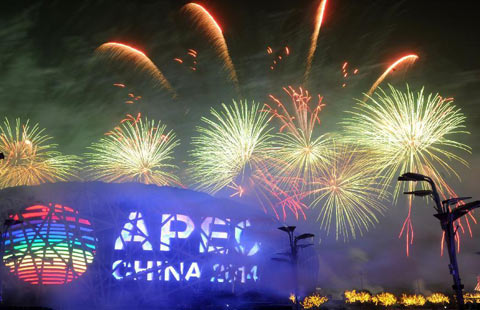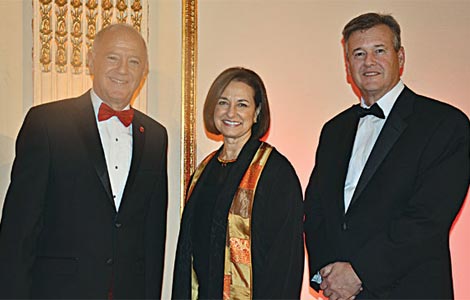Innovation, reform, win-win co-op prosper Asia-Pacific region
Updated: 2014-11-10 17:01
(Xinhua)
|
||||||||
BEIJING -- Innovative development, economic reform and regional integration provide new divers for economic growth of Asia-Pacific and the broader world, given the tepid recovery in some developed economies and slowdown in some emerging ones.
The Asia-Pacific, compared with other regions, has enjoyed robust economic growth, serving as an anchor of world stability and a foundation of global prosperity.
But it still faces challenges, with many emerging economies in the region hitting a development bottleneck.
The latest Economic Trends Analysis Report issued Thursday by the APEC Policy Support Unit said GDP of all Asia-Pacific Economic Cooperation (APEC) economies grew only 3.9 percent in the first half of this year, down from the 4.3 percent in the second half of 2013.
The intra-regional trade growth in the first half of 2014 plunged sharply from two digits four years ago to a dismal 1.2 percent now.
It is imperative to adopt innovative thinking and action and conduct pragmatic reforms to find new pillars for high-quality growth.
World Bank Managing Director Sri Mulyani Indrawati has said both emerging and developed economies need to deepen and accelerate domestic reforms at present, "as you cannot depend on macro-economic policies as stimulus for your growth."
China, a pioneer on this front, has started restructuring its economy and adjusting the growth model from an investment-relied economy to one supported by consumption and higher productivity.
China has also put forth a series of major cooperation initiatives, such as the Silk Road Economic Belt and the 21st Century Maritime Silk Road, for interconnected development.
A lack of new economic growth has left many Asia-Pacific economies pinning high expectation on connectivity, said Tang Guoqiang, chairman of the China National Committee for Pacific Economic Cooperation Council.
It is more encouraging that ministers of APEC members on Saturday reached consensus on the Beijing Roadmap to push forward the Free Trade Area of the Asia-Pacific (FTAAP) process.
When established, the FTAAP, the largest FTA in the world, can not only avoid the "spaghetti bowl" dilemma, but also unleash much greater economic vigor than other regional trade arrangements. And if completed, it will add an estimated 2.4 trillion U.S. dollars of output to the global economy.
The APEC Economic Leaders' Meeting in Beijing on Nov. 10-11 comes as the region now stands "at a crossroad."
"The development prospect of our region hinges on the decisions and actions we take today," Chinese President Xi Jinping noted.
As priorities of the APEC Beijing Meeting, the initiatives of innovation, reform and interconnected development can help the region and the broader world sail through the rough economic ride.

 All cheers for wedding expos
All cheers for wedding expos
 Magnificent fireworks showed at APEC grand banquet
Magnificent fireworks showed at APEC grand banquet
 Chinese-style outfits designed for participants of APEC
Chinese-style outfits designed for participants of APEC
 Aviation airshow takes off in S China’s Guangdong
Aviation airshow takes off in S China’s Guangdong
 Consul-General Yuan says goodbye to San Francisco
Consul-General Yuan says goodbye to San Francisco
 Kissinger: 'Overcome' issues
Kissinger: 'Overcome' issues
 Peaking for APEC
Peaking for APEC
 Scenery near Yanqi Lake in Beijing
Scenery near Yanqi Lake in Beijing
Most Viewed
Editor's Picks

|

|

|

|

|

|
Today's Top News
Visit brings schools closer
Anbang US hotel deal raises queries
A stroll sets stage for diplomacy
Shanghai railway stations use US Wi-Fi technology
Tencent looks to the final travel frontier
Relaxed stroll sets mood for Xi, Obama
All cheers for wedding expos
Night view of Beijing's APEC Meeting site
US Weekly

|

|








